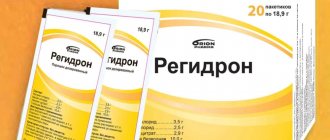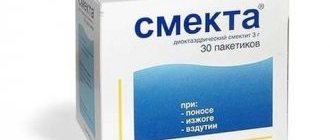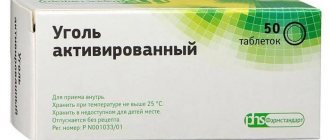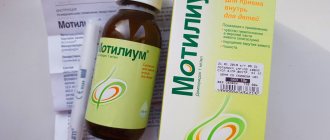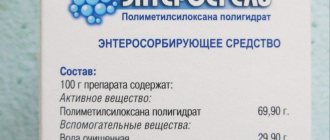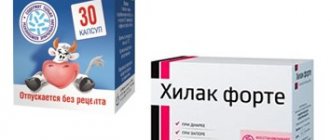Diarrhea in a child is a common occurrence, for the treatment of which effective Levomycetin is used. Instructions for using tablets for diarrhea in children must be carefully studied and all recommendations of the attending physician taken into account.
There can be many reasons for diarrhea in children:
- Insufficient hand hygiene;
- Food poisoning;
- Pathogenic microorganisms found in raw water;
- Stress and much more.
Bacterial diarrhea caused by the development of an intestinal infection is treated with antibiotics, one of the most effective and affordable is Levomycetin.
Composition and release form
Levomycetin is produced in the form of yellowish tablets. It contains several ingredients:
- Chloramphenicol is the active substance of the drug. This is an antibiotic that disrupts the formation of protein elements of pathogenic microorganisms and blocks these structures.
- Polyvinylpyrrolidone is a binder. With its help, it is possible to accelerate the distribution of the drug in the body and facilitate absorption by the digestive system.
- Calcium stearate is a stabilizing agent.
- Potato starch is a stabilizer. With its help, it is possible to give the tablets the desired color and shape.
Properties of Levomycetin
The compound was first obtained in 1947 from actinomycete fungi. Currently, chloramphenicol is produced synthetically. Despite its high antimicrobial activity, Levomycetin is rarely used in medical practice due to increased toxicity to humans.
When tablets containing chloramphenicol are taken orally, severe side effects develop.
Hematopoietic disorders are observed in people with a hereditary predisposition. This phenomenon is rare, but can develop even after a single dose. Levomycetin is flat white tablets with a bitter taste.
The dosage of tablets is 250 or 500 mg of active substance.
To mask the bitter taste of the drug, manufacturers created Levomycetin Actitab in film-coated tablets. The drug is used for local treatment. Produced in the form of drops, an alcohol solution.
Action of the antibiotic
Chloramphenicol exhibits bacteriostatic activity. The antibiotic molecule does not kill bacteria, but stops their reproduction by blocking the peptidyl transferase enzyme. This leads to the cessation of protein synthesis. The activity of chloramphenicol extends to microorganisms:
- Gram positive
. The group includes strains of streptococci, pneumococci, and staphylococci. - Gram-negative
. These include gonococci, meningococci, Escherichia coli, Haemophilus influenzae, Shigella, Salmonella, Klebsiella, Yersinia, Rickettsia, Serratia, Chlamydia, and spirochetes.
Taking an antibiotic rarely leads to resistance in pathogenic microflora. Meningococci (Neisseria meningitides) are most sensitive to the antibacterial agent. This allows the antibiotic to be used in the treatment of infectious meningitis.
Features of pharmacokinetics and pharmacodynamics
The antibiotic is easily absorbed, penetrates the placenta, passes through the blood-brain barrier, and is found in breast milk. The highest concentrations of the active substance are observed in the tissues of the brain, lungs, and synovial fluid of joints. Antibiotic metabolism occurs in the liver. It is excreted from the body through the kidneys.
One day after taking Levomycetin tablets, 90% of the drug leaves the body.
The half-life of the drug, during which half of the substance taken is eliminated from the body, is up to 3.5 hours in adults, and in case of kidney disease it increases to 11 hours.
Chloramphenicol is excreted worst of all by the kidneys of newborns. The half-life of the antibiotic in newborns is 24 hours. With repeated doses of the drug, concentrations of chloramphenicol increase, causing it to become extremely toxic.
Operating principle
Is it possible to give Levomycetin to children? First of all, you need to study its effect on the body.
Levomycetin analogues: review of effective drugs
The properties of the drug are determined by its composition. Active ingredients actively suppress protein synthesis in the structure of pathogenic microorganisms. This effect is achieved at the molecular level. As a result, it is possible to remove the source of inflammation.
Quite often Levomycetin is prescribed to children for diarrhea. This remedy not only successfully copes with the symptoms, but also eliminates the cause of the disease.
Diarrhea occurs as a result of bacteria entering the digestive system. As a result, inflammation develops, which causes indigestion. Under the influence of the drug, pathogenic microorganisms die. This allows you to actively use Levomycetin for diarrhea.
Analogs
Levomycetin is an inexpensive and effective remedy, but with an impressive list of side effects and contraindications. If necessary, the doctor can replace it with other antibacterial medications. Unauthorized substitution of therapy by the patient is prohibited.
An alternative to Levomycetin can be Ceftriaxone, an antibiotic that is active against Salmonella, Shigella, Proteus, and intestinal Escherichia. Available in powder form for the preparation of an injection solution. Can be prescribed to newborn children if there are appropriate indications, and to pregnant women. During lactation, feeding the baby must be stopped during therapy. Contraindications include only individual intolerance to cephalosporin antibiotics.
Another common analogue of Levomycetin is Normax, an antibiotic of the second generation fluoroquinolone group. Compared to other antibacterial agents, it has an extended spectrum of action. But this medication has more contraindications: it can only be used when the patient reaches the age of majority, and in the absence of individual intolerance. The drug is approved for use during pregnancy; There is no exact data regarding the period of breastfeeding.
source
Indications
Many parents are interested in whether it is possible to give this remedy to their children and in what cases it is better to do so. The main indications for use of the substance include the following:
- Infectious and inflammatory pathologies that were provoked by the activity of microbes and bacteria sensitive to
- active ingredients of the medicine;
- chronic pathologies of the biliary tract;
- typhoid fever;
- meningitis;
- purulent peritonitis;
- pneumonia;
- chlamydia.
This is not a complete list of conditions for which this remedy should be used. It is actively prescribed to children for diarrhea. Levomycetin is sometimes used for runny noses in children, but it is permissible to do this only if the pathology is of a bacterial nature.
Features of application
Before giving tablets to children, you need to carefully study the instructions. The description contains the following recommendations:
- Levomycetin tablets should be taken orally before meals. This avoids damage to the epithelial mucosa of the digestive system.
- It is permissible to use the product no more than once every 4 hours.
- To speed up the effect of the drug and improve absorption in the digestive organs, the tablet must be bitten before use. However, it has a very bitter taste, which is why many children prefer to swallow the tablet whole.
- After taking the product, you should drink it with a large volume of water. You can add a small amount of sugar to the liquid.
The dosage is selected depending on the age of the baby. Despite its simple composition, the medicine is considered a potent substance. That’s why it’s so important to take into account a number of features:
- For children under 3 years of age, the volume of the drug is prescribed depending on weight - 10-15 mg per 1 kg of body weight;
- at 3-8 years old the dosage is 0.15-2 g;
- Older children can be given 0.2-0.3 g for every kilogram of weight.
Levomycetin for diarrhea: instructions for use of the drug
Levomycetin for diarrhea is taken 3-4 times a day. Reviews from doctors indicate that the specific number of uses depends on the severity of the disease.
The duration of therapy with this drug is 7-10 days. If well tolerated and there are no adverse reactions, the duration of treatment can be increased to 2 weeks.
Interaction with other drugs
It is possible to increase the duration of the therapeutic effect of alfetalin in the pre- and postoperative period. The half-life of the drug increases when taken simultaneously with paracetamol. There is a risk of suppression of the hematopoietic system when combining chloramphenicol with ristomycin, cytostatic drugs, cimetidine, sulfonamides and radiation therapy.
The effectiveness of oral contraceptives that contain folic acid, iron, cyanocobalamin and estrogens is reduced. There is a decrease in the plasma concentration of chloramphenicol with additional intake of rifabutin, rifampicin, and phenobarbital. Levomycetin enhances the effect of using oral medications to lower blood sugar levels.
A disulfiram-like reaction occurs when the drug is combined with ethyl alcohol. Alcohol causes weakness, migraines, vomiting, and nausea. A decrease in the effectiveness of all drugs is facilitated by taking Levomycetin with erythromycin, penicillin, nystatin, clindamycin, levorin, and cephalosporins. Cycloserine increases the neurotoxicity of the antibiotic.
Read: Let's defeat Helicobacter: treatment with antibiotics
The medicine changes the pharmacological properties of drugs whose action occurs using the cytochrome P450 system. The same effect is observed when Levomycetin is combined with cyclophosphamides, phenytoin, tacropimus, and cyclosporine. If combined treatment is necessary, the doctor must adjust the dosage of the drugs.
Active immunization of the body should not include additional administration of Levomycetin. The consequences of this combination range from diarrhea to acute colitis.
Contraindications
The instructions for Levomycetin contain a number of contraindications for the use of this substance. These include the following:
- Individual intolerance to the drug;
- skin diseases, including eczema, psoriasis, fungus;
- inhibition of hematopoietic function.
Levomycetin is not used for newborns. Also, it should not be taken for tonsillitis, acute respiratory viral infections, or mild forms of infectious pathologies.
The use of Levomycetin for children is prohibited in conjunction with such drugs as Difenin, Butamide, Neodicoumarin. This medicine should not be combined with barbiturates, cytostatics, or sulfonamides. Do not take it with pyrazolone derivatives.
Side effects
When answering the question whether children can use this drug, it is very important to analyze its side effects:
- Dyspeptic symptoms, nausea and vomiting may appear on the part of the digestive system. There is also a risk of irritation of the oral mucosa, stomatitis, dysbacteriosis, and enterocolitis.
- The hematopoietic organs may react to the use of the drug by developing leukopenia, thrombocytopenia, and reticulocytopenia. Pancytopenia, granulocytopenia, and erythrocytopenia may also be observed.
- If the nervous system is damaged, there is a risk of psychomotor impairment, depression, and confusion. A person may experience optic neuritis, hallucinations, and headaches. Sometimes peripheral neuritis appears, hearing and visual acuity decreases.
Light-colored stool in children: causes and possible diseases
The drug can also provoke allergic reactions, which manifest themselves in the form of skin rashes and angioedema. If a baby takes the drug, it may develop collapse.
It is strictly forbidden to give medication to newborns. This is fraught with the development of the so-called gray syndrome. It is accompanied by bloating, cyanosis, respiratory distress, and vomiting. As the anomaly progresses, there is a risk of developing vasomotor collapse. If given to a newborn, hyperthermia and acidosis may occur.
On a note. The cause of this syndrome is the accumulation of chloramphenicol, which is caused by the immaturity of liver enzymes. This substance has a toxic effect on the myocardium. The risk of death in this case is 40%.
Overdose
It is important to understand that Levimycetin is a strong antibiotic, and an overdose can lead to serious consequences.
Let's look at them:
- In case of overdose, hematopoietic function is impaired. This is accompanied by pale and gray skin, severe weakness, increased body temperature, possible severe sore throat, difficulty breathing and problems with the heart.
- A severe overdose can lead to serious problems and liver and kidney disease. A large amount of the drug can cause disruption of the work and function of these organs.
- Large doses can disrupt the functioning of the human digestive tract , destroy the mucous membrane and lead to serious diseases of the gastrointestinal tract.
- An overdose can lead to deterioration of vision and hearing.
At the first manifestations of an overdose of the drug, it is strongly recommended to rinse the stomach. To do this, you need to drink a large amount of water and then induce vomiting. It is advisable to repeat this procedure several times.
It is also necessary to go to the hospital to avoid the possible consequences of an overdose. The medical facility will prescribe a number of medications that can help the body recover, and may also perform an intestinal lavage procedure.
In cases where there is a large overdose, you must immediately call an ambulance. The sooner you contact a specialist, the greater the likelihood that the overdose will pass without serious consequences for the body.


